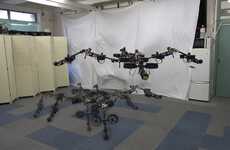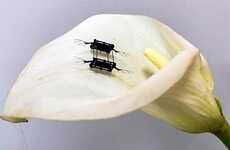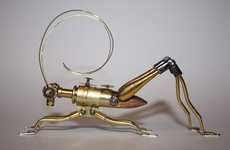
The Columbia University DNA ‘Spiderbot' is Made Out of Microscopic Mo
References: cosmosmagazine & dailymail
The Columbia University DNA ‘Spiderbot’ was recently featured in the science journal Nature. These microscopic robots are made out of DNA and can run, create tiny products, build computer components, and even help surgeons clean human arteries.
The Columbia University DNA ‘Spiderbot’ is 10,000 times smaller than the diameter of a human hair, and can even identify diseases within human cells and destroy them.
Implications - With the rapid advancement of microtechnology, scientists and roboticists are discovering that their work can positively effect the health care field, especially in the realm of surgery. These miniature robots do work at a scale that is currently impossible, opening the door for new-age treatments.
The Columbia University DNA ‘Spiderbot’ is 10,000 times smaller than the diameter of a human hair, and can even identify diseases within human cells and destroy them.
Implications - With the rapid advancement of microtechnology, scientists and roboticists are discovering that their work can positively effect the health care field, especially in the realm of surgery. These miniature robots do work at a scale that is currently impossible, opening the door for new-age treatments.
Trend Themes
1. Microscopic Robotics - The Columbia University DNA 'Spiderbot' represents a trend in the development of microscopic robots with potential applications in healthcare and surgery.
2. Dna-based Technology - The use of DNA as a building material for robots, as demonstrated by the Columbia University Spiderbot, presents disruptive innovation opportunities in various industries such as healthcare and manufacturing.
3. Advanced Medical Treatments - The application of small-scale robots like the Columbia University 'Spiderbot' in surgery and disease identification opens up possibilities for innovative medical treatments and targeted therapies.
Industry Implications
1. Healthcare - The development of microscopic robots like the Columbia University DNA 'Spiderbot' offers disruptive innovation opportunities for precision medicine, targeted therapies, and minimally invasive surgical procedures.
2. Robotics - The use of DNA as a building material for microscopic robots introduces disruptive innovation possibilities for advanced robotics applications in industries ranging from healthcare to manufacturing.
3. Biotechnology - The integration of DNA-based technology and robotics, exemplified by the Columbia University DNA 'Spiderbot', creates disruptive innovation potential for advancements in biotechnology research, drug delivery, and tissue engineering.
3.8
Score
Popularity
Activity
Freshness























